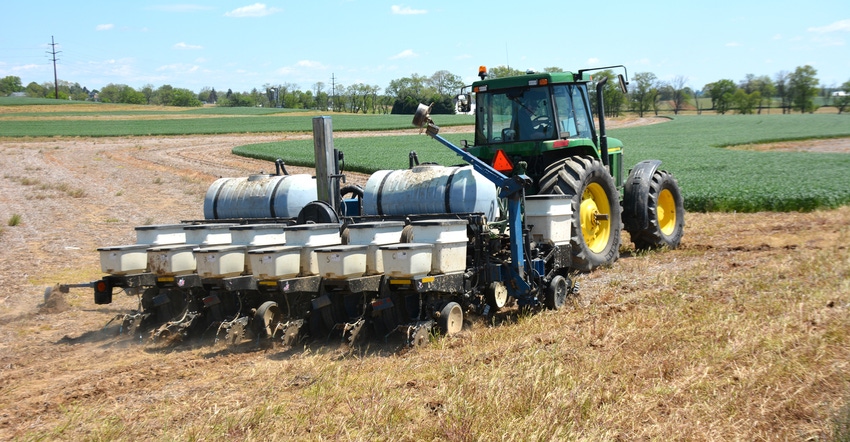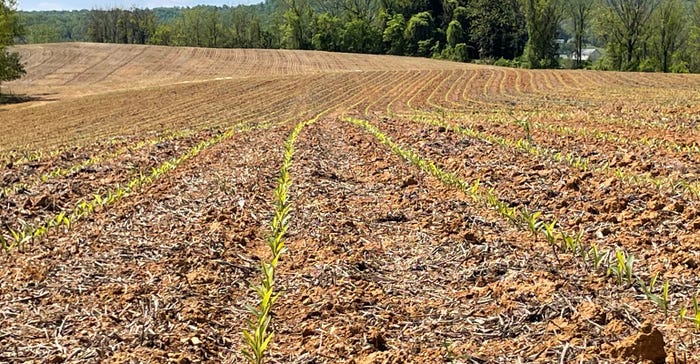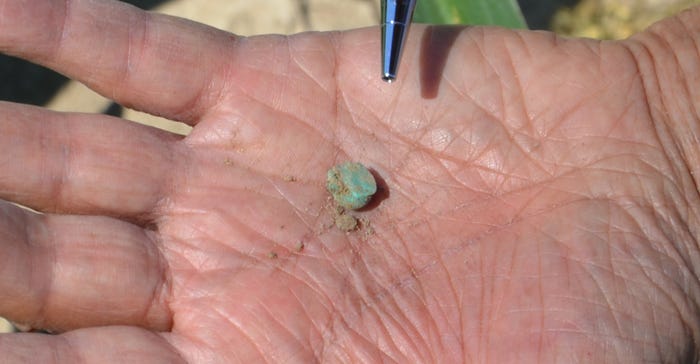
After a quick start to the planting season in mid-April, cool, damp weather across the Northeast slowed planting to a crawl in early May. And now farmers are playing catch-up.
“What we have planted is starting to come through the ground nicely, but it’s been a cooler-than-normal spring,” says Jim Hershey, who planted much of his 200 acres of corn and 150 acres of soybeans during an ideal planting window in April.
Since then, his fieldwork has slowed, and seeds planted early this month have been slow to emerge. It’s too early to say if he’ll be replanting, but that might be a possibility.
The percentage of Pennsylvania corn planted, at 33%, is actually ahead of the five-year pace of 23%, according to the latest Crop Progress Report by the National Agricultural Statistics Service. About 7% of soybeans have been planted thus far.
But Maryland and Delaware growers have fallen behind.
“It’s been slow,” says Chip Bowling, who farms in Newburg, Md. He’s planted 450 acres of corn and is now planting some of his 1,200 acres of soybeans. But planting was 10 to 12 days later than normal because of the cold, wet weather in southern Maryland, he says. Last week, temperatures were in the mid-60s and cloudy. Normally, temperatures should be in the low to mid-70s with plenty of sun.
The percentage of corn planted in Maryland is 27%, well behind the state’s five-year average of 42%. About 15% of soybeans have been planted, and only 30% of wheat is heading — well behind the five-year average of 57% heading.
In Delaware, 28% of corn is planted, behind the five-year average of 44%. Barley — 74% heading —and wheat — 50% heading — are about average for this time of year.

EARLY EMERGENCE: Corn has emerged nicely at the Jeff Zimmerman farm in Schaefferstown, Pa. This field was planted in April.
Jeff Graybill, Penn State Extension educator in Lancaster, Pa., says crop progress depends on the farm and if they got out early.
“I have seen some excellent fields of corn that are already at the two-leaf stage here in Lancaster. Also, beans at the V1 stage. It seems the guys who took a chance and planted mid-April benefited by that really warm week we had,” Graybill says.
“Those that planted in the past two weeks have seen almost no heat units and almost no emergence or growth. I think it is too early to tell about poor stands, but I am seeing that guys who did a late burndown to allow the cover crop to gain biomass are experiencing a very slow die-off from the glyphosate.
"In some cases, the corn is already planted and is starting to push through while the cover is still green and standing tall. This may not be good for uniform emergence and growth of the corn, and we may even see some allelopathy in those fields. Hopefully, the cover will soon die off, and the corn will even up as the cover lays down.”
Bryan Harnish, who farms 600 acres of field crops in Pequea, Pa., has already finished planting his corn and soybeans. About 75% of the crop is emerged, he says, and now he’s ready to plant pumpkins, watermelons and tobacco.
Hershey started planting soybeans April 16. “Those beans are up very nice," he says. "What we planted 10 days ago, that’s a little early to tell what the success of that is."
He also grows 200 acres of winter wheat. Like last year, which was a banner year for wheat in the Northeast, his crop overwintered nicely and has really greened up.
“The wheat looks really good. I think the potential for wheat is good this year,” Hershey says.
Farther west, Glenn Brake, who grows 400 acres of crops for his 120-head dairy in Mercersburg, Pa., says he’s a week behind with corn planting because of the colder-than-normal weather. But forage harvest is on schedule, and yields are looking good, he says.
Eric Rosenbaum, owner of Rosetree Consulting LLC in Shillington, Pa., says growers can get a good sense of how much replanting they might have to do by digging up some samples in different places and doing comparisons. If you have some wet spots, get some samples from there, but also get samples from your high spots, your best-yielding spots and spots that are about average.
“A healthy root system will have root hairs. If you go into a wet field and you have no root hairs … the plant is under more stress,” Rosenbaum says.
“This way, you’ll definitely get a handle on severity, and it’ll be easier to make replant decisions,” he says.
Belinda Burrier, who grows 230 acres of corn, high-oleic soybeans and 120 acres of winter wheat in Union Bridge, Md., is done with corn planting. But soybeans, normally in the ground by now, are lagging. The wet weather’s been holding up planting beans, and she and her husband are still working on getting the planter ready.

IN-FIELD INVESTIGATION: Dave Nanda, who helps coordinate the Corn Watch '21 field for Farm Progress, holds a seed that didn’t germinate in a field. If you suspect you might need to replant, go through a field and dig out samples in several areas, and see if root hairs are starting to emerge. This is a sign that a field is in good condition or might need to be replanted.
Meanwhile, Ohio and Michigan farmers have taken advantage of dry spells to get a lot of corn and soybeans planted.
The Crop Progress Report for Ohio shows 27% of the state’s corn and 20% of soybeans planted, which are both about average for this time of year. Michigan farmers are even further ahead. The report shows 46% of corn planted, well ahead of the five-year average of 19%, and 42% of soybeans planted, ahead of the five-year average of 11%.
A warmer-than-usual April allowed farmers in western New York to haul manure and get early spring seedings planted. But since then, planters have been parked.
“It’s definitely a struggle. It’s been cold and wet. Not many acres have been planted. Thus far, we estimate that around 5% to 10% of corn’s been planted, which is way behind,” says Dave DeGolyer of the Western New York Crop Management Association, which covers 400,000 acres of field crops in western New York and northern Pennsylvania.
New York’s Crop Progress Report shows 41% of barley planted, well-ahead of the five-year average of 26%. Spring oats are 47% planted, also ahead of its five-year average of 38%.
“March and April were unbelievable," DeGolyer says. "Manure was moved, spring seedings were put in. The wheat crop looks great. I’m very pleased. Triticale looks reasonably well, and alfalfa and grasses got a head start, but then they slowed down here. Hopefully, the weather will continue to get better.”
“It seemed like April and May kind of switched us in weather,” he says.
About the Author(s)
You May Also Like






